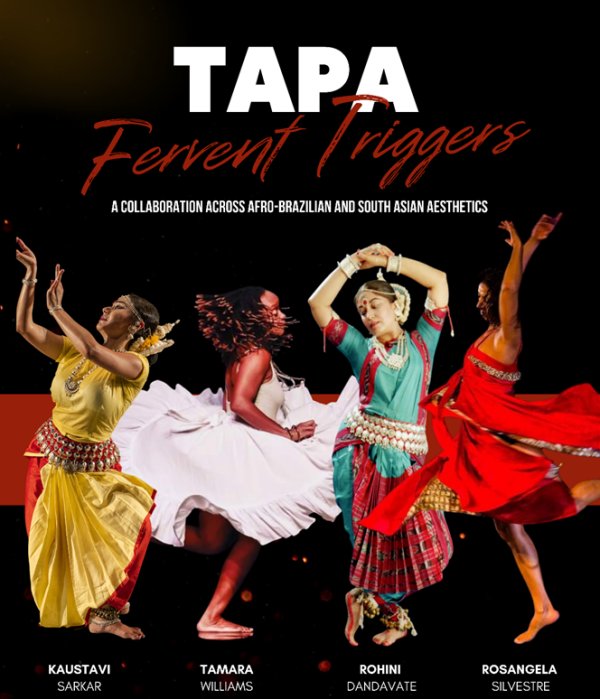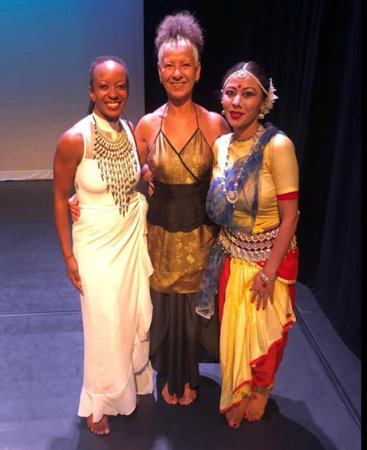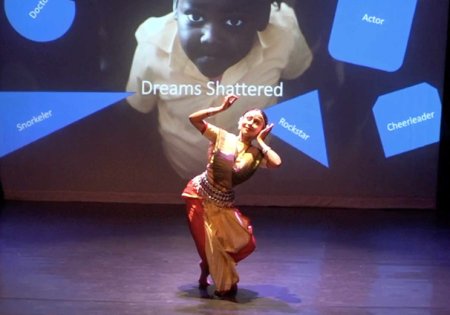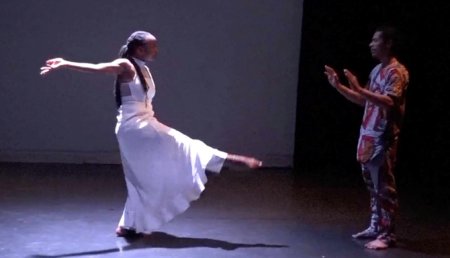
|   |

|   |
TAPA: Fervent triggers - Manjula Nadkarni November 27, 2023  My mother and I were lucky to watch this profoundly moving choreographic work, Tapa: Fervent Triggers, at Counter Pulse in San Francisco on March 4, 2023. Seeing art bubble up in a city, finding its spark again was incredible. Sometimes, you are so moved by a piece that it takes a while to understand why. Dr. Rohini Dandavate, a doyen of the classical Odissi tradition, addressed the contemporary moment of environmental catastrophe, political confusion, and social unrest. Her piece sparked anxious questions, and she answered them with hope. The dance collaboration across Afro-Brazilian and South Asian aesthetics features prominent choreographers and performing artistes Rohini Dandavate, Rosangela Silvestre, Kaustavi Sarkar, Tamara Williams, and Luciano Xavier. The three-part production includes 1. Fire 2. Trigger 3. A Question The captivating blend of the classical Odissi form and contemporary themes makes for a powerful call to action. At once poetic and poignant, the dances tackle complex themes with the compassion and curiosity of an artiste par excellence.  Tamara Williams, Roseangela Silvestre, Kaustavi Sarkar Rohini's choreography combines abhinaya (facial expressiveness), Pallavi (expanding a melodic framework through dance sequences or Nritya, and Nritta). She effortlessly merges the powerful energy of a young, vibrant dancer, Dr. Kaustavi Sarkar, with the grace, tradition, and observation of an expansive lived experience. I walked out of the theater, stunned and inspired. The duality was searing. The pieces ask urgent questions of humanity. To consider our ability to both create and destroy. I found myself asking questions and finding answers in the work. How do you emerge from the darkness of the pandemic, from a shift in the universe with something so beautiful and inspiring? During the pandemic, one heard of family and friends passing away, some our age, some way younger, a lot much older. You could cut through the anxiety and stress with a knife. It just stayed there in the air. It robbed us of the fine line between work and life. We worked from our bedrooms and our kitchen tables. In this isolating space, these artistes collaborated to find community and inspiration.  Tamara Williams As one of the artistes glided across the floor with a mirror, you could immediately see the differences and similarities of the Odissi and Silvestri traditions. Her interplay with the audience was quiet and dramatic, asking us to be reflective and think about our choices and our impact on the world. Ans: Creativity combines our various experiences with the voices of others. Inspiration and light can be found in dark times. Art compels you to move the world forward with positive action. As an artiste, how do you balance the patriarchy of the traditional Guru Shishya parampara (unwavering, unquestioning devotion to the guru) with intellectual curiosity and artistic freedom? As the dancer, are you the inspiration, the muse or the expression? Both Kaustavi and Rohini are scholars who deeply question this dichotomy in their work. Years of tradition remake the art form to express urgent issues for our present-day, like climate change. The element of Fire is represented both as a sacred fire for worship and a destroyer of life. We are asked to consider what we are doing with our power to affect climate change. It is up to us as humanity to decide how we wield power. Ans: An artiste's finest work comes from the rigor of a classical tradition merging with the free form of a bold, lived experience and a feeling of flow. As a woman how does an artiste find the space for self-expression and creativity when you are torn with the demands of a full life? As working women and artistes, there is a constant tug between the freedom for self-expression and the love for friends, and family- the need to care for people around us. Seeing my dear friend and mentor bring a volcanic explosion of artistic resonance after years of quiet reflection gave me so much joy. You can see her empathy flow in the piece on gun violence. Instead of focusing on the act, she imagines what artistic lives could've been without it.  Kaustavi Sarkar Ans: As women, our empathy gives us an inside view, an ability to walk in other shoes, to predict futures. Emotion and the ability to feel deeply, and express ourselves is the true measure of an artist. As an immigrant of color, where is home? As immigrants, you always live in suspended disbelief, a feeling of wanting to find a place to call home. Belonging everywhere and nowhere. Change is constant, and artistes who embrace it, find their humanity, expression, and joy in embracing their lived experience. Trauma and tenacity, resistance and resilience, grief and acceptance. Home is found in the journey. Home is found when we are finally at peace with where we are.  Tamara Williams and Luciano Xavier Manjula Nadkarni is a creative leader, filmmaker, futurist, and a startup CEO supercharging the world's creativity. Born in India, raised in the Middle East, and forged in the US, she thrives at the intersection of culture, media, entertainment and technology. As a perpetual immigrant and world traveler, she is committed to raising all her communities through positive action. |